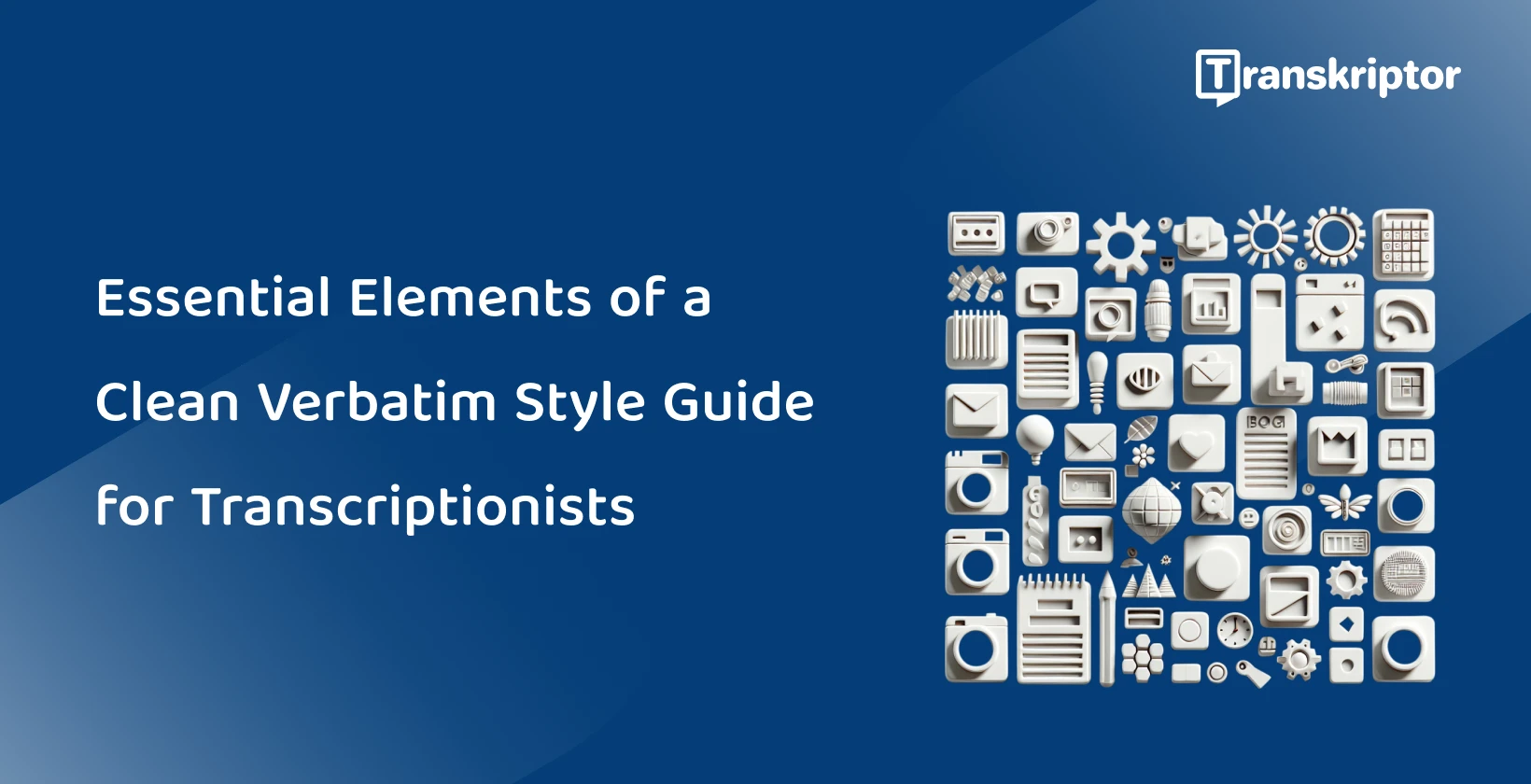What is a Clean Verbatim Style Guide?
Before diving into the essential elements, let's define what a clean verbatim style guide is. Put simply, clean verbatim transcription captures the speaker's words accurately, removing unnecessary elements like ums, ahs, repeated words, and false starts that don’t add any meaning to the text. This style aims to create a clear, readable transcript that reflects the speaker's intended message - all without the distractions of verbatim speech. In short, the style guide for clean verbatim transcription outlines the rules and standards for achieving this balance, ensuring consistency across all transcribed files.

Key Elements of a Clean Verbatim Style Guide
Omission of Fillers and False Starts
One of the cornerstone rules in a clean verbatim style guide is the omission of fillers (e.g., "um," "uh," "you know") and false starts, where a speaker begins a sentence and then restarts it. Generally speaking, these elements can be omitted as they don’t contribute much to the overall meaning of the text, and can end up making the transcript less readable.
Handling of Repetitions
Repetitions are common in natural speech, but can end up cluttering a transcript unnecessarily, so the style guide should specify which repetitions to remove (for clarity) and which to keep (for emphasis or when they contribute to the context). Learn more about handling repetitions in verbatim transcription. Typically, in legal contexts - or when dealing with a research-based transcript - repetitions might be kept in the transcript in order to accurately convey the speaker’s intonations, emotions, or intentions.
Slang and Idiomatic Expressions
Slang and idiomatic expressions also present a unique challenge in transcription, and a clean verbatim style guide should address how to handle these elements, especially when dealing with slang in clean verbatim . Typically, slang can be transcribed as spoken to preserve the speaker's voice and the content's authenticity.
Non-Verbal Communication
Finally, it’s also important to note that the guide should outline how to deal with non-verbal communication cues, such as laughter, pauses, and sighs, or how to handle clean verbatim transcription. Depending on the context and client requirements, these may be omitted or noted in a specific way - again, in legal or research matters, it may be best to keep non-verbal communication in the transcript to ensure thorough and full comprehension for third-party readers.
Formatting and Presentation Standards
When it comes to creating a comprehensive clean verbatim style guide, it’s also important to include standards for formatting and presenting the transcript; this can include guidelines for speaker identification, timestamps, paragraph breaks, and the use of punctuation to reflect the tone and pace of the spoken word accurately.
Revision and Quality Assurance Processes
Revision and quality assurance are critical components of the transcription process. The style guide should detail the steps for reviewing and editing transcripts to ensure they meet the clean verbatim standards. This might include guidelines for proofreading, consistency checks, and the use of software tools to aid in the quality assurance process.
Client-Specific Preferences and Adaptability
Like when doing any job, transcriptionists might often end up working with a roster of diverse clients who may have specific preferences or requirements, so adaptability is key. As a transcriptor, your clean verbatim style guide should have some wiggle room for flexibility, providing a framework for incorporating client-specific instructions without compromising the integrity of the clean verbatim approach.
Tips for Creating and Using a Clean Verbatim Style Guide
- Be Comprehensive: Cover all aspects of the transcription process, from initial listening to final proofreading.
- Stay Flexible: Be prepared to adapt the guide to meet specific client needs or accommodate different types of audio content. You can also incorporate various tools, such as an audio to text AI transcription service to speed up the process and make editing simpler.
- Promote Consistency: Use the guide as a training tool for new transcriptionists and a reference for experienced professionals to ensure consistency across all transcripts.
- Update Regularly: Language and client needs evolve, so periodically review and update the style guide to reflect current best practices, such as incorporating guidelines for music transcription .
Ultimately, creating and adhering to a clean verbatim style guide is essential for any transcriptionist who’s aiming to deliver high-quality, accurate transcripts, either for themselves or third-party clients, including including those working in closed captioning jobs . By focusing on the key elements outlined above, you can ensure your transcripts meet professional standards and satisfy client requirements with ease, making your transcription service stand out in a competitive market, particularly when it comes to specialized areas like transcribing numbers . So no matter whether you're transcribing interviews, lectures, or any other audio content, a well-crafted clean verbatim style guide is an invaluable resource in your transcription toolkit.

